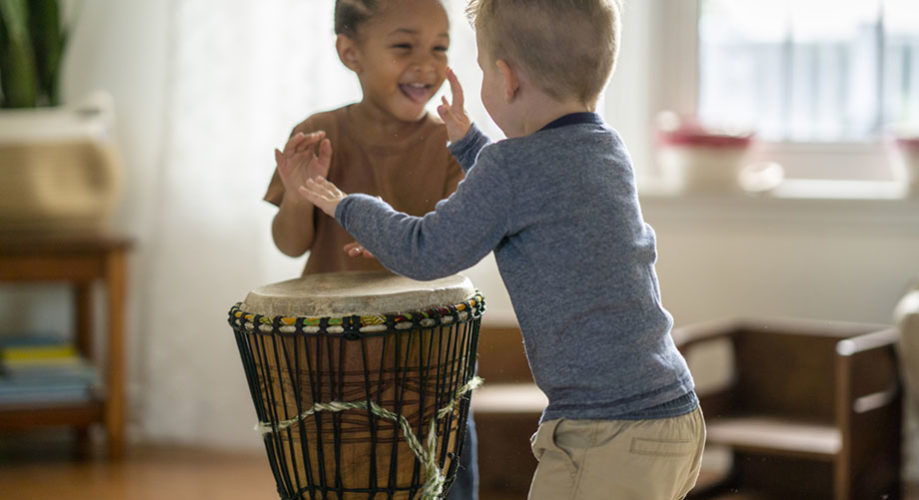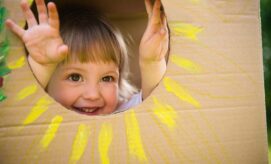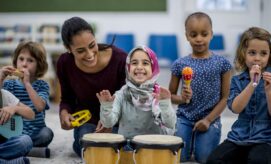Music is a familiar component of the curriculum for those who work with young children. Educators often sing “good morning” songs during circle time, play peaceful instrumentals during naptime, and use transition songs to help children move from one activity to the next. Music is a powerful tool, not only as a support for daily routines but also as a contributor to early development and learning. Music facilitates connections between the body and mind, which helps to support children’s rapidly developing brains. Through music, children learn about creativity, connection, and communication, all of which help them to be more successful in their learning and relationship-building.
Music Strengthens Early Relationship-building
As early educators, we know that between birth and age 5, learning takes place in the context of relationships. Music is a powerful tool for strengthening connections between young children and their caregivers, and for facilitating relationships among children. When we listen to music with a young child, we enjoy a shared experience that strengthens the caregiver/child bond. For older toddlers and preschoolers, group activities in which children sing, dance, and move together help them connect and form relationships with their peers.
Music can also connect children to their heritage and roots. When we ask families about the music they enjoy at home and then play that music with the children, we help build a connection between school and home that enhances families’ sense of belonging in the classroom. In the article, Getting in Tune: The Powerful Influence of Music on Young Children’s Development, ZERO TO THREE explains, “An African-American spiritual, a Yiddish or Irish lullaby, a Mexican folk song…all introduce…the family’s heritage in a way that goes beyond words or pictures. And connecting to roots is another way to make a child feel safer and more secure.”
Music Enhances Social-Emotional Learning
Music can help to support young children’s social-emotional development by strengthening a variety of skills. Lauren Guilmartin, director of Early Learning Music Together, explains that “group music-making challenges children to work with others as an ‘ensemble.’ They learn the importance of respecting others’ space and how they express themselves. They also get to practice working together towards a common goal (e.g., when holding hands while dancing)…Making music in a group also challenges children to watch the people around them for subtle cues to timing, volume, and expressiveness—the same cues that we use for reading expressions and moods on people’s faces. Being able to perceive and understand people’s feelings is a basis for empathy.”
As educators, we can use music to model emotional regulation by showing children how upbeat songs can help to energize us and peaceful music helps us to calm down. The lyrics in many songs expand children’s emotional vocabulary and introduce examples of empathy. And, when we invite children to choose their favorite songs or lead the group in a music and movement activity, we help support their self-confidence and leadership skills.
Music Supports Foundational Academic Learning
Creativity & Expression
Music has the power to invoke different moods and emotions. For young children, playing an instrument or dancing to a song can provide an emotional outlet and a chance for them to express their feelings.
ZERO TO THREE describes music as a “springboard for creativity and imagination…Toddlers enjoy making up nonsense words and new sounds to fit to familiar melodies, and they often make up songs to accompany activities. All of this helps develop young minds and goes a long way toward nurturing a love of musical sound and language. Making up new songs with babies is a perfect way to encourage creativity. For example, songs to accompany everyday routines— such as “Happy Bathtime to You” — use imagination to make these activities more fun.”
Math & Numeracy
Music provides an engaging and joyful way to introduce early mathematical skills and concepts. An article from the University of Washington’s Circle Time Magazine explains that listening to music and songs helps children “notice, describe, create, and extend patterns during everyday experiences. Patterns can involve…movement, sound, rhythm, and sequences of events.”
Many songs, such as Five Little Monkeys, include numbers and introduce simple counting. When singing these songs with children, invite them to count along. The patterns and repetition help children to become familiar with counting and one-to-one correspondence.
Speech & Language
Music and language have a lot in common. Both use elements like rhythm, sound, timing and tone to convey meaning. This is why music can have a positive impact on speech and language development. Music therapist and educator, Carla Tanguay, MA, MT-BC explains, “We now know that literacy is strongly connected to sound patterns, or phonological awareness. In fact, how well preschool-aged children can detect rhythms correlates with their future reading abilities. Engagement in music is all about sound awareness and exploration, and strengthens the same areas of the brain associated with reading and language skills…Active involvement in music provides opportunities to practice many important academic and pre-academic skills.”
Movement & Motor Skills
From stomping our feet to banging on a drum, creating and listening to music is a physical experience. When young children dance and move their bodies to a song, they are using gross motor skills and developing a sense of balance. Fine motor skills are developed when children hold shakers and small instruments, or incorporate hand gestures, such as the hand movements to The Itsy-Bitsy Spider.
Children love music, movement, and laughter, all of which come into play in this fun motor development example described in a ZERO TO THREE article: “Imagine that ‘Let’s Do the Twist’ fills the room. Young toddlers try to copy their family child care provider’s movements, twisting and shaking to the beat, while attempting to stay balanced and not fall over! (Of course, falling over is often the fun part.)”
Resources for Further Exploration






